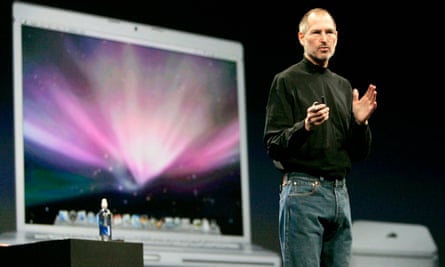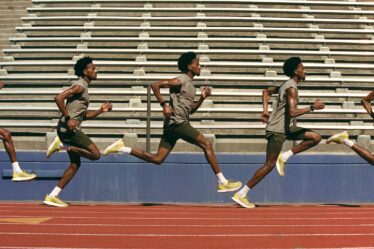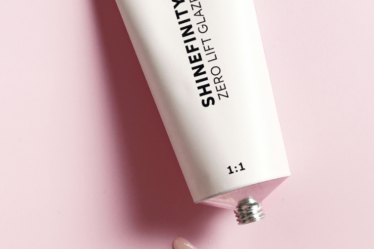
Last Tuesday an undisclosed buyer paid $218,000 for a pair of Birkenstock sandals. It was not just any pair of shoes, obviously. The website listing for Julien’s Auctions said: “The cork-and-jute footbed retains the imprint of Steve Jobs’ feet, which had been shaped after years of use.”
“The sandals were part of his simple side,” Chrisann Brennan, Jobs’s former girlfriend and the mother of his child, told Vogue Germany in 2018. “They were his uniform.”
Jobs is famous for having co-founded Apple in 1976, but it could be argued that he was just as well regarded for his strict approach to fashion. Black Issey Miyake turtleneck jumpers (Jobs was said to own more than 100 of them) worn with Levi’s 501 jeans plus New Balance trainers or Birkenstocks didn’t just form the cornerstone of his wardrobe, they were its entirety.
Just as Vogue’s Anna Wintour has become instantly identifiable by her sharp bob haircut, and Kim Kardashian by her body shape, Jobs’s trademark was his uniform. It’s an approach that many successful people have since tried to emulate.
The uniform of Karl Lagerfeld, the late creative director of Chanel, consisted of a starched white shirt, a black blazer and trousers and a pair of fingerless gloves. Both Hillary Clinton and Nancy Pelosi are known for their colourful trouser suits.
Disgraced Theranos founder Elizabeth Holmes is said to have honed her signature look of a black roll neck jumper (and red lipstick) after reading about Jobs’s approach while Meta’s Mark Zuckerberg opts for a grey T-shirt and jeans.
“The great thing about a uniform is that you don’t have to give any thought to what to wear in the morning,” Brennan told Vogue Germany. “He would never have done or bought anything just to make himself stand out. He just believed in the intelligence and practicality of the design … And in Birkenstocks he didn’t feel like a businessman, so he had the freedom to be creative and think creatively.”

It is this freedom of thought hypothesis that also appeals to people such as Zuckerberg. In 2014, at a Facebook public Q&A session, he was asked why he wore the same T-shirt every day. Dressed in said grey T-shirt, he replied: “I’m in this really lucky position where I get to wake up every day and help serve more than a billion people. I really want to clear my life to make it so that I have to make as few decisions as possible about anything, except how to best serve this community.”
This idea of streamlining decision-making dates back to the 1800s. In his 1892 book Psychology: The Briefer Course, American philosopher William James wrote: “The more of the details of our daily life we can hand over to the effortless custody of automatism, the more our higher powers of mind will be set free for their own proper work. There is no more miserable human being than one in whom nothing is habitual but indecision, and for whom the lighting of every cigar, the drinking of every cup, the time of rising and going to bed every day, and the beginning of every bit of work, are subjects of express volitional deliberation.”
In 1998 the social psychologist Roy F Baumeister coined the term “decision fatigue”. Based on Sigmund Freud’s theory of ego depletion, it essentially describes the way a person’s choices become poorer the more decisions they are forced to make. It’s estimated that the average adult makes 35,000 decisions every day. If you’ve ever stood in front of your wardrobe at 7am debating whether to wear trousers or jeans, or struggled to reply when a barista asks if you want a regular or medium latte, you’ll know that even little decisions can cause stress. Automating how you get dressed means saving energy to focus on more complex questions.

Since the war in Ukraine started, President Volodymyr Zelenskiy has swapped a statesmanlike shirt and tie for a green hoodie, cargo pants and sneakers. Even after accusations of being out of touch during the cost of living crisis, the prime minister, Rishi Sunak, continues to appear in his signature £3,500 suits, with £450 loafers from Prada. His uniform is the norm among the one percenters he mingles with. It’s the same type of “quiet luxury” the hit TV series Succession brilliantly captured. Tom wears a logoed Moncler gilet while Kendall wears more inconspicuous brands such as Brunello Cucinelli. They probably cost more but aren’t instantly identifiable.
This type of identity politics lies behind the Gen Z obsession with creating “starter packs’’ to share on social media. These are visual guides to the clothing, accessories and other items (oat milk, say) that capture the essence of a particular cohort. A “geography teacher” collection, for example, features beige corduroy trousers and a green cardigan while a “Rich Mom” set includes a pair of Lululemon leggings, a Birkin handbag and a green juice.
The architecture world is another industry that has an almost implicit uniform. In an interview, Swiss architect Jacques Herzog said: “Everybody creates his or her own architecture, which then becomes part of the city. Clothes are a kind of link between the public and the private, just like a house.”
Luke Matone, a London-based architect in his 30s, says a “baker’s jacket” and matching trousers from Universal Works are in the wardrobe of every architect he knows. “It’s smart but casual… It’s a way of wearing a suit without wearing an actual suit.”
Uniforms make fertile ground for satirists. Through black-and-white cartoons he posts on Instagram, Welsh artist Bedwyr Williams regularly pokes fun at creative types and their unofficial uniforms.
Carolyn Mair, a fashion psychologist, says uniform dressing isn’t lazy – in fact, it’s “cognitively smart”. As for how long it takes for others to notice a uniform, Mair says it depends how much someone exhibits themselves. “It’s easier for people in the public eye as we see images of them all the time. It’s a repetition effect: it’s all about exposure.”



